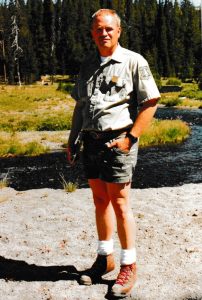
By Les Joslin
I made such a good start at those campsite surveys during 1990 that some of my Three Sisters Wilderness work during summer 1991 was focused on gathering information for a study about how visitors use and perceive wilderness. This put me in a position to meet about five times as many visitors as I had met the previous summer.
A trailhead—especially a heavily-used one—is a good place to contact wilderness visitors. There, where people begin and end wilderness visits, an appropriate Forest Service representative can do a lot of good. Visitors may be made to feel welcome—which they are—and provided useful information. Regulations may be explained. And violations of regulations—and thus, impact on the wilderness resource and the wilderness experiences of other visitors—may be prevented. And, in those days, permits—if required—could be issued.
I spent about a third of my wilderness duty days that second summer at the Green Lakes Trailhead, the most used Three Sisters Wilderness access point. There, for nine hours a day, I collected visitor use data through interviews and surveys, explained the new wilderness permit system instituted that summer, and answered questions.
That new wilderness permit resulted in the most questions. Yes, I answered, self-issued day-use wilderness permits—previously required in the late 1970s and early 1980s—were required from Memorial Day weekend through October. I likened these permits, for which there was no charge, to visit registrations. It was a softer word. Overnight permits were issued by forest officers.
One regulation, prohibiting use of mechanized equipment—including mountain bikes—in the wilderness, required frequent explanation. One day that summer, after explaining the wilderness idea to two young men with mountain bikes who wanted to follow two young women on horseback around the Fall Creek-Soda Creek loop trail, I explained how any form of mechanical transport—except wheelchairs—is incompatible with the legal and ethical definitions of wilderness. They accepted my explanation, and the map of Deschutes National Forest mountain bike trails I offered as an alternative.
“Have you ever seen a wheelchair in the wilderness?” one asked.
“No, I haven’t,” I replied.
But, as fate would have it, I did later that afternoon. A man and wife with two children, one a seriously handicapped toddler in a three-wheeled conveyance, arrived at the trailhead. The conveyance qualified as a wheelchair.
“We plan to go in for a night or two. It’ll be the kids’ first time,” the man explained. “We thought we’d try Green Lakes. What do you think?”
“Well, it’s pretty late in the day to start for the Green Lakes, especially with the children. And the weather forecast calls for storms in the Cascades tonight. If you’re going into the wilderness, I think you’d be better off going to Moraine Lake. It’s closer, easier to get to, and there’s more cover there.” I told him how to get there, and showed him on a map. The couple thanked me.
“Do you have an overnight wilderness permit?” I asked. At that time, overnight permits had to be issued by a forest officer.
“No. Guess we forgot to get one.”
“I’ll issue you a permit, and you can be on your way.”
And soon they were. I admired their determination to experience the wilderness with their children despite their young son’s condition.
It stormed that night.
Thank you for your service!
Thanks for this reminiscence, Les. What’s your opinion about human-powered travel—mainly mountain biking—in Wilderness now? What about horses and packstock?
I emailed Les and he said he will be back and answering questions in early October.